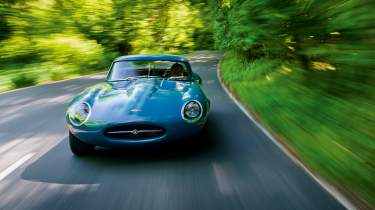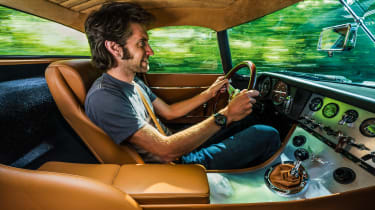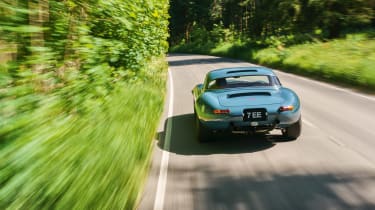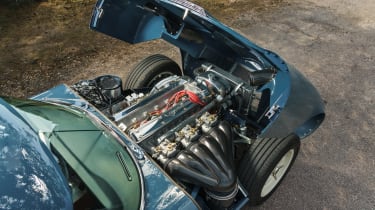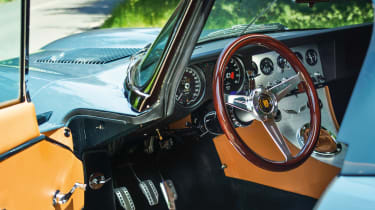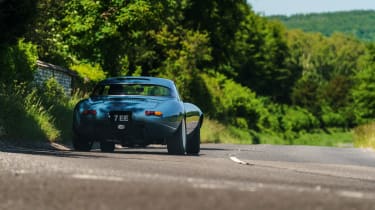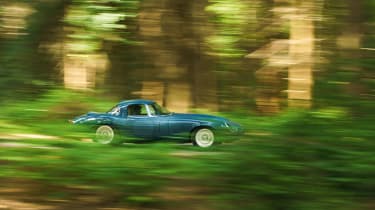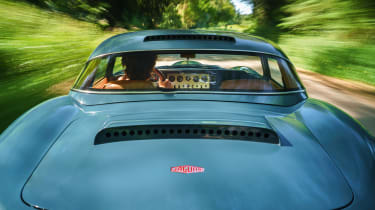Eagle Jaguar E-type Lightweight 2022 review
Road-racer restomods come little more sublime than Eagle’s take on the Jaguar E-type Lightweight
A warm, spring morning. The air is still. Just hanging out, minding its own business, maintaining that mix of mostly nitrogen with a slug of oxygen and a few other gasses to make up the last one per cent. Pressure? Somewhere just over 1000mbar or 100kPa as it’s down near sea level. All is calm.
Then along comes the Lightweight GT. Suddenly the previously peaceful air is dragged through a carbonfibre antechamber into one of three Weber carburettors. Throttle wide open, the air accelerates towards the gulping engine, a Venturi effect drawing out petrol into the airstream on the way. Then it’s sucked through a big valve in a wide-angle head, down into a cylinder. Compression. Ignition. Fire in the hole!
A rush for the exit through an Inconel corridor that opens into a titanium tunnel. A tumble out of the flume ride into a swirling slipstream that mingles with the warm spring air. After a minute or so, all is calm once more.
> Jaguar F-Type review – flying the flag for the great British sports car
As the driver controlling the passage of the air through those fabulous Weber carburettors, the air’s journey is represented by the sounds created: the glorious induction noise at one end and the rorty exhaust note at the other. They are the sort of noises that make you feel intimately connected to the engine in a way rarely found in new cars these days. From the moment you twist the key and then press the starter button – remembering to help the engine catch with the throttle pedal to instigate the first racily flatulent report – you are aware of your right foot orchestrating a complex procedure. You feel connected to the physics in the process, not simply the dynamic result.
Of course, this is not, strictly speaking, a new car, but so immaculate is this freshly finished modified restoration, or restomod, that it’s hard not to think of it as such. This is the latest of Eagle’s extraordinary E-types. The company based in the folds of the Sussex countryside has been restoring and modifying Jaguar’s most famous car since the mid-’90s. Initially the standard Sayer look of the cars was retained, but then in 2009 the first of The Specials was released into the world. It was called the Eagle Speedster and the plaudits were plentiful. Next up was the gorgeous Low Drag GT in 2014, then a Spyder GT in 2016. Each one is a tremendously time-consuming and expensive work of art. Eagle is cagey about just how much they cost and of course it depends on exact specification, but it’s safe to assume it’s above the realms of an 812 Superfast or Aventador and more in the league of a McLaren Senna or Aston’s V12 Speedster. Only 17 Specials have been produced to date: seven Speedsters, seven Low Drag GTs, two Spyder GTs and now this, the first Lightweight GT.
It has been built as an homage to the dozen Lightweight race cars of the early ’60s, but rather than simply being a race rep it has been given a much more useable road racer leaning (hence the GT part of the name). Like all the Eagle Specials, the aluminium bodywork has been sympathetically sculpted to give it a subtly more muscular and modern appearance. The sills are lower, the arches wider, and both the bespoke windscreen and rear screen on the hard-top have more rake. Those are the big-ticket changes, but there are also more detailed tweaks such as the flush indicators, the hidden seals and the frameless doors that declutter and lend a smoother finish to the whole car. Then there are the specifics to this car: from the obvious, such as the hard-top and the vents in the roof and boot, to the subtle, such as the flared, rather than blistered, front arches.
From an engineering perspective it feels like this is the car where Eagle’s updates and Jaguar’s own in-period improvements meet. The original Lightweight race cars had aluminium bodywork instead of steel, they used aluminium blocks for the engines, they had five-speed gearboxes and they altered the suspension geometry – all things that Eagle has also been applying to its road car specials.
The engine is a 380bhp and 375lb ft, 4.7-litre all-aluminium straight-six with wide-angle heads and big valves. The suspension geometry of all Eagles is altered to make much better use of the characteristics of radial tyres. Cross-ply rubber was only fitted to Series 1 E-types, but for some reason Jaguar never changed the suspension in later iterations of its road cars and left them set up for the older-style rubber.
The Lightweight part of this car’s moniker is clearly fulfilled by the aluminium already mentioned, but this particular example takes the weight saving to new levels. Magnesium is used for the 16-inch ‘peg drive’ wheels. It is also used for the hubs. And the sump, gearbox, and differential housing. There are tubular driveshafts, lightweight wishbones and a lithium battery. Perhaps what Eagle is most proud of, however, are its new aluminium three-eared wheel spinner nuts. These have been tricky to design and produce because they have to withstand being knocked on and off with a copper hammer, but the rewards for the effort of making them are additional savings in both unsprung and rotational mass.
Marginal gains maybe, but the end result is a dry weight of just 1017kg and a car that drives beautifully. Heading through the chalky hills and thick woodland surrounding Goodwood on a sunny day, the Lightweight GT feels fabulous. The cabin feels much airier than I was expecting. From the outside I’ve always looked at the Lightweight’s hard-top and thought it would be rather claustrophobic inside, but the sheer amount of glass that wraps almost continuously round you means it feels wonderfully light. This feeling of brightness is probably helped by the shimmering swathe of dimpled aluminium that runs down the centre of the cockpit, and the physical roominess and headroom that I have is largely due to the lower floor.
Curiously, lightness is not something that initially comes across in the driving experience. You might be expecting adjectives such as flighty or lithe given all the weight saving parts, but the sensations through the controls are ones of strength and tautness. Devoid of assistance, there is a wonderfully unfiltered feeling to the steering and a sense of connection through the pedals. The car’s lightness is felt more as a secondary element through the eager acceleration and the pliancy in the primary ride.
It’s a relatively resilient secondary ride, particularly at low speed, but this gives the car some of its focused attitude, which fits with the civilised racer character. It’s never harsh or uncomfortable though, and once there is a bit of pace you can sense everything become more fluid as the Öhlins dampers get into their stride. A couple of times I expected a bump or hole in the road to send a shudder through the steering and/or chassis, but the bigger hits were always soaked up so deftly that they were almost inconsequential.
The car’s comfort, the GT part of its brief, is also aided hugely by the beautiful seats. Simple in design, they seem to cradle you at just the right angle and the plushness of the cushioning is offset by the security of the bolstering. You sink into them snuggly, like an armchair that has been fitted around you by a keen-eyed gentleman from Savile Row discreetly flourishing chalk, pins and a tape measure.
The reason you require such support around the torso is that the Eagle encourages you to get stuck in with the process of cornering and there is also a surprising amount of grip on offer. In the past this has sometimes felt a little intimidating with Eagle’s Specials, but on the Lightweight GT there is a lovely sense through the wheel and your backside as to how the car leans into the tyres as you turn into a bend. It seems to settle into the sidewalls more quickly too, giving you the confidence to push with either lock or throttle.
Rather like a 911, an E-type has its own distinctive balance that can take a bit of getting used to when you first get behind the wheel. Staring out across the gills and bulges of that loooong bonnet you feel like you’ve got a lot of car to get into any corner ahead of you. Imagine you’re a waiter holding a tray of drinks navigating through a crowded room. Instinctively you’d hold the tray close to you, but in the E-type there is a sense that you’re holding the tray at arm’s length. Perhaps that makes it sound too precarious, but you get the idea; the E-type can feel like a long car because of how far you are away from the front wheels.
In fact, once you’ve got used to tipping the nose in a fraction early you can be quite aggressive with the front end and confidently push the front tyres. Then your attention switches to the rear axle, which, in contrast to the front wheels, feels as though it is right underneath your backside. There is a lovely sense as you drive through a corner on the throttle of just how the car is sitting into its rear suspension. In this left-hand-drive car the feeling is increased through right-hand corners where you’re on top of the outside tyre.
Get aggressive with the throttle and you can feel as soon as the tyres start to slip. You can feel the car digging deeper into its travel but moving progressively and controllably. Of course, because you’re nearer the outside of the arc, the angles of any oversteer feel exaggerated, but the precision in the controls combined with that almost granular sense of how much traction the Vredesteins are finding also gives you confidence to enjoy riding out slides.
Then it’s away up the next straight through the beech trees and you can revel in the glorious engine. The Eagles I’ve driven before have all had either SU carburettors or fuel injection, but to link this one more directly to the original competition Lightweights it was decided that Webers were the right way to go. Weber was founded in 1923 and, until 1992, made its carburettors in Bologna. Now the company is owned by Magneti Marelli and manufacturing has moved to Spain, but the design is the same. The full name of the carbs fitted to this car is Weber 45 DCOE 152G. The 45 refers to the bore of the throttle in millimetres. The letters stand for Doppio Corpo Orizzontale (with the ‘E’ being a type reference), which translates as ‘double body horizontal’, so they are side draft as opposed to down draft carbs. The final letters and numbers refer to the series, with the G on these ones indicating four progression holes as opposed to three (making them less prone to flat spots as you move through the rev range).
While SU carbs give a lovely, smooth delivery, there is something very addictive about the more aggressive nature of the Webers. They can be tricky to set up, yet this engine feels very happy sitting at low to medium revs where you might expect some lumpiness or recalcitrance. But it’s as the needle sweeps past 3600rpm that the advantages of the twin chokes (one for each cylinder) gulping in air become vividly apparent. Suddenly there is a distinct, almost VTEC hardening of the engine note and a step change in the acceleration as the engine really hits its stride. It’s wonderfully addictive having this snarling powerband and the nice thing is that it feels very attainable. It’s not like the final 500rpm flurry of a 991.1 GT3, which is glorious but so often feels out of reach, this is a sweet spot that can be accessed and enjoyed easily.
The engine really feels like it wants you to keep reaching for that zone above 3600rpm too. You can potter around happily short-shifting if you want, but even then you can find yourself piling on speed almost without realising it. It’s a car that wants to go fast.
Talking of the gearshift, there is a very distinct throw to the ’box. The little black ball sits nice and high so falls easily to hand, but the movement as you push the lever around the gate is a long one. It almost feels like you’re going to get fifth when you initially go from second to third, but it’s just a very diagonal shift, with what feels like almost as much movement horizontally as vertically. It’s not obstructive in any way and after the initial familiarisation I rather like it, as you’re given longer to savour each change.
In fact the whole car is something to savour. It’s not a car that you want to simply walk up to and leap in. The looks are so delectable that you want to take a tour round it at least once, letting your eyes wander over the bodywork before opening the small door. The same level of appreciation is required as you settle into the interior with its blend of original and improved. Then the starting procedure, which is like coaxing something to life. And on the move you’ve got the engine, the steering, the suspension, the handling, the noise, the noise, the noise…
A warm, spring evening. The air is still as you stand next to the road in the heart of the South Downs. Just hanging out, minding your own business. Then you hear it. The sound is distant and muffled by the trees initially, but distinctive. Then it’s gone. A twist in the road, a closed throttle.
But moments later it’s back, louder and getting closer. Then a sleek shape, resplendent in RAF blue, slips into sight, bringing the noise with it a moment later on a wave of acceleration. There is doppler distortion but it doesn’t diminish the soundtrack from the six cylinders. Aggressive but not angry. Raucous but not raw. The exhaust note rips through the air around you as the long bonnet flashes past. The tall grass in the verge, rustled by the swirling slipstream, sways back and forth as you listen to the music recede. A trailing throttle, an explosive report, then a gently fading XK growl. After a few seconds all is calm once more.
This feature was first published in evo issue 276. Browse back issues here.

